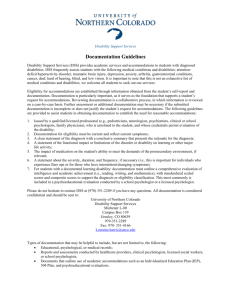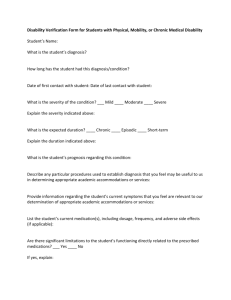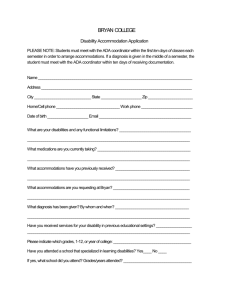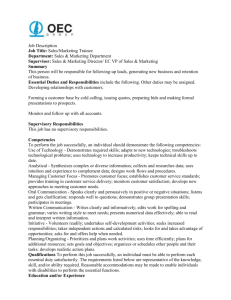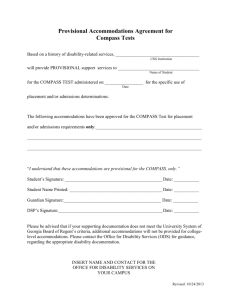Employing Special Education Considerations: Backward Design
advertisement
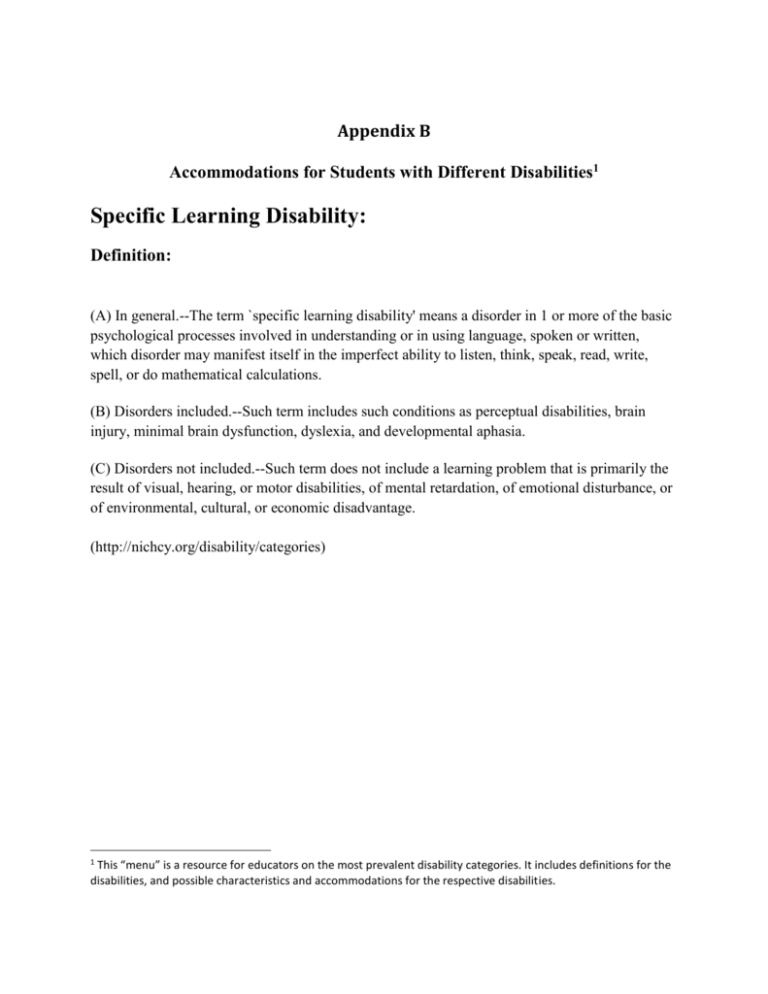
Appendix B Accommodations for Students with Different Disabilities1 Specific Learning Disability: Definition: (A) In general.--The term `specific learning disability' means a disorder in 1 or more of the basic psychological processes involved in understanding or in using language, spoken or written, which disorder may manifest itself in the imperfect ability to listen, think, speak, read, write, spell, or do mathematical calculations. (B) Disorders included.--Such term includes such conditions as perceptual disabilities, brain injury, minimal brain dysfunction, dyslexia, and developmental aphasia. (C) Disorders not included.--Such term does not include a learning problem that is primarily the result of visual, hearing, or motor disabilities, of mental retardation, of emotional disturbance, or of environmental, cultural, or economic disadvantage. (http://nichcy.org/disability/categories) 1 This “menu” is a resource for educators on the most prevalent disability categories. It includes definitions for the disabilities, and possible characteristics and accommodations for the respective disabilities. Dysgraphia: Definition: Dysgraphia is a learning disability that affects writing, which requires a complex set of motor and information processing skills. Dysgraphia makes the act of writing difficult. It can lead to problems with spelling, poor handwriting and putting thoughts on paper. People with dysgraphia can have trouble organizing letters, numbers and words on a line or page. This can result partly from: Visual-spatial difficulties: trouble processing what the eye sees and language processing difficulty: trouble processing and making sense of what the ear hears (http://www.ncld.org/types-learning-disabilities/dysgraphia/what-is-dysgraphia) Characteristics: 1. Combines cursive and print when writing 2. Grips writing utensils unusually (to the point of causing pain) 3. Omits words or does not complete them 4. Copies or writes slowly 5. Cannot write and think simultaneously (http://www.ldanatl.org/aboutld/parents/ld_basics/dysgraphia.asp) Accommodations: 1. Assess child using audio/visual recordings. 2. Allow student to dictate to a note-taker or writer. 3. Provide students with copies of instructions and assignments. 4. Allow students to type answers and assignments. 5. Create shortened assignments with regard to writing. (Classroom Accommodations Checklist) Dyscalculia: Definition: Dyscalculia refers to a wide range of lifelong learning disabilities involving math. There is no single type of math disability. Dyscalculia can vary from person to person. And, it can affect people differently at different stages of life. (http://www.ncld.org/types-learning-disabilities/dyscalculia/what-is-dyscalculia) Characteristics: 1. Have trouble recalling mathematical facts from memory 2. Use methods of calculating facts that are under grade level 3. Write incorrect numbers 4. Trouble following mathematical steps and processes 5. Problems differentiating between letters, numbers, and symbols (http://scholarcommons.usf.edu/cgi/viewcontent.cgi?article=contextnumeracy) Accommodations: 1. Use computer models during math lessons. 2. Provide student with maps, charts, tables, etc. 3. Emphasize important information. 4. Allow students to use computer programs to practice skills. 5. Incorporate manipulatives into lesson plans. (Classroom Accommodations Checklist) Dyslexia: Definition: As with other learning disabilities, dyslexia is a lifelong challenge. This language-based processing disorder can hinder reading, writing, spelling and sometimes even speaking. Dyslexia is not a sign of poor intelligence or laziness or the result of impaired hearing or vision. Children and adults with dyslexia have a neurological disorder that causes their brains to process and interpret information differently. (http://www.noodletools.com/noodlebib/cite.php?ADD=Web%20Site) Characteristics: 1. Trouble distinguishing similar letters 2. Problems with taking notes during class 3. Speech is delayed 4. Reading rate is slowed 5. Problems with structures of words (http://www.hsutx.edu/offices/literacy-learning/dyslexia-characteristics) Accommodations: 1. Create and maintain simple daily routines. 2. Repeat important information and directions. 3. Communicate with both verbal and visual information. 4. Break instructions into steps. 5. Give the student a graphic organizer. (http://www.ncld.org/students-disabilities/) Visual Impairment: Definition: Visual impairment including blindness means an impairment in vision that, even with correction, adversely affects a child’s educational performance. The term includes both partial sight and blindness. (http://idea.ed.gov/explore/view/p/%2Croot) Characteristics: 1. Discoloration of pupils (may appear white instead of black) 2. Constantly blink or squint 3. Repeatedly cover or close eyes 4. Hold objects too close to face 5. Avoid activities that require average vision (http://nichcy.org/disability/specific/visualimpariment) Accommodations: 1. Provide braille versions of text. 2. Provide books with enlarged print. 3. Use concrete materials as often as possible. 4. Emboss copies of handouts and worksheets. 5. Constantly talk while you teach. (Classroom Accommodations Checklist) Emotional/Behavioral Disorders: Definition: An emotional disorder is a condition exhibiting one or more of the following characteristics over a long period of time and to a marked degree that adversely affects a child’s educational performance: (A) An inability to learn that cannot be explained by intellectual, sensory, or health factors. (B) An inability to build or maintain satisfactory interpersonal relationships with peers and teachers. (C) Inappropriate types of behavior or feelings under normal circumstances. (D) A general pervasive mood of unhappiness or depression. (E) A tendency to develop physical symptoms or fears associated with personal or school problems.” (http://idea.ed.gov/explore/search) Characteristics: 1. Bullies fellow classmates 2. Acts aggressively 3. Self-injurious tendencies 4. Disrupts classroom activities 5. Problems with working in groups (http://www.gallaudet.edu/clerc_center/information_and_resources/) Accommodations: 1. Provide preferential seating for the student, away from distractions. 2. Offer positive and negative reinforcements for good and bad behavior. 3. Create a quiet space where the student can retreat to when necessary. 4. Communicate with other members of the IEP team often. 5. Create a list of increasing consequences. (Classroom Accommodations Checklist) Orthopedic Impairment: Definition: A physical disability means a severe orthopedic impairment that adversely affects a child's educational performance. The term includes impairments caused by a congenital anomaly, impairments caused by disease (e.g., poliomyelitis, bone tuberculosis), and impairments from other causes (e.g., cerebral palsy, amputations, and fractures or burns that cause contractures). (http://idea.ed.gov/explore/view/) Characteristics: 1. Impaired motor skills 2. Possible partial immobility 3. May appear fatigued (trouble sleeping) 4. May have pain or discomfort 5. Poor self-advocacy skills (http://www.education.com/reference/article/orthopedic-impairments/) Accommodations: 1. Allow the student extra time to get to each class. 2. Ensure that the classroom is accessible. 3. Allow the students extended time to do out-of-class assignments. 4. Provide the necessary assistive technology. 5. Ensure that any fieldtrips will have total accessibility. (http://ddce.utexas.edu/disability/tips-for-working-with-students) Autism: Definition: Autism means a developmental disability significantly affecting verbal and nonverbal communication and social interaction, generally evident before age three, that adversely affects a child's educational performance. Other characteristics often associated with autism are engagement in repetitive activities and stereotyped movements, resistance to environmental change or change in daily routines, and unusual responses to sensory experiences. (http://idea.ed.gov/explore/view/p/) Characteristics: 1. Problems with making and maintaining eye contact 2. Shows little interest in activities 3. Difficulty with communicating 4. Lacks imaginative skills 5. Uses little body language when interacting with classmates (http://www.pbs.org/parents/inclusivecommunities/autism2.html) Accommodations: 1. Create a repetitive and routine schedule. 2. Use visual, auditory, and tactile stimuli during lessons. 3. Identify and remove any possible distractions. 4. Use minimal figurative language and be very direct. 5. Pair the student with a peer helper. (http://www.superduperinc.com/handouts/pdf/134_autismintheclassroom.pdf) Intellectual Disability: Definition: Intellectual disability means significantly subaverage general intellectual functioning, existing concurrently with deficits in adaptive behavior and manifested during the developmental period, that adversely affects a child's educational performance (http://idea.ed.gov/explore/view/p/) Characteristics: 1. Social development is abnormal 2. Cognitive development is delayed 3. Language impairments 4. May have unusual physical attributes 5. Acts without age-appropriate behaviors (http://www.livestrong.com/article/) Accommodations: 1. Provide the student with checklists. 2. Allow oral assessments. 3. Have the student dictate and use a writer during assessments. 4. Provide extra written instructions. 5. Give verbal cues and reminders. (http://askjan.org/media/intcog.html)


